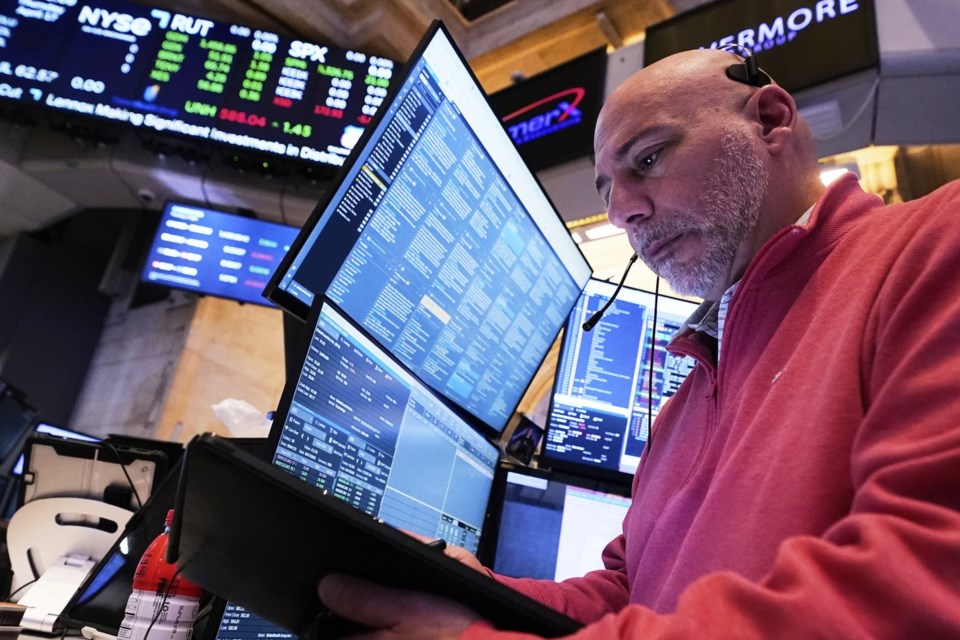NEW YORK (AP) — Most U.S. stocks rose, but the worst drop for UnitedHealth Group in a quarter of a century kept Wall Street in check. The S&P 500 edged up 0.1% Thursday even as three-quarters of the stocks within the index climbed. Another drop for Nvidia helped pull the Nasdaq composite down 0.1%. The Dow Jones Industrial Average slumped 1.3%. That was almost entirely because UnitedHealth Group plunged 22.4% to its worst loss since 1998 after a weaker-than-expected profit report. Treasury yields rose following mixed data on the U.S. economy. President Donald Trump again criticized the Federal Reserve for not lowering interest rates.
THIS IS A BREAKING NEWS UPDATE. AP’s earlier story follows below.
NEW YORK (AP) — Most U.S. stocks are climbing Thursday, but the worst drop for in a quarter of a century is keeping Wall Street in check.
The S&P 500 was 0.5% higher in late trading, as 6 out of every 7 stocks within the index climbed in the final day of trading for a holiday-shortened week. The Nasdaq composite was up 0.1% after steadying from its .
The Dow Jones Industrial Average was an outlier and down 391 points, or 1%, with an hour remaining in trading. The drop was due almost entirely to just one stock, UnitedHealth Group, which fell 23.2% following a weaker-than-expected profit report.
Helping to lead the way higher on Wall Street was Eli Lilly, which jumped 16.1% after the drugmaker reported encouraging results for a once-daily pill that could help treat people with obesity and diabetes.
Stocks of oil producers also lifted the market after the price of crude rose to recover some of its sharp losses taken this month. Exxon Mobil added 3.3%, and ConocoPhillips climbed 3.5%.
Technology stocks held firmer after global heavyweight Taiwan Semiconductor Manufacturing Co. reported a profit for the latest quarter that matched analysts’ expectations. Perhaps more importantly, it also said it hasn’t seen a drop-off in activity from its customers because of , as some other companies have suggested.
Still, the company known as TSMC was cautious. “While we have not seen any changes in our customers’ behavior so far, uncertainties and risks from the potential impact from tariff policies exist,” Chief Financial Officer Wendell Huang said. TSMC’s stock that trades in the United States rose 0.8%.
They helped offset UnitedHealth's drop, on track to be its worst since 1998, after it for financial results this year. It was surprised by how much care its Medicare Advantage customers were getting from doctors and outpatient services, which was above the company’s expectations.
Another high-profile stock, , weighed on the market after sinking a second straight day following its disclosure that new export limits on chips to China could hurt its first-quarter results by $5.5 billion. It sank 2.6%.
Uncertainty still remains high about tariffs, which Trump wants to bring manufacturing jobs back to the United States and trim how much more it imports than it exports. Economists worry that the tariffs, if fully implemented and left in place for a while, could cause a .
Trump on Thursday offered some encouraging signals that negotiations with other countries could lead to lower tariffs, which is what Wall Street is hoping for.
The uncertainty about what will happen in Trump’s on-again-off-again rollout of tariffs, though, could by itself damage the economy. Federal Reserve Chair Jerome Powell helped send stocks lower Wednesday that Trump’s tariffs appear to be larger than the central bank was expecting, which could in turn slow the economy and raise inflation more than it had earlier thought.
That could set up a dilemma for the Fed. It could cut interest rates to help the economy, but that would also push inflation higher. It has no good tool to fix both at the same time. Powell said again on Wednesday that the Fed would wait to see how conditions play out more before moving on interest rates.
Trump Thursday, saying the Fed is “always TOO LATE AND WRONG.” He also said, “Powell’s termination cannot come fast enough!”
That could spook Wall Street. An independent Fed from the White House is one of the primary reasons the United States has benefited from its reputation as a safe place to invest. History suggests central banks with more autonomy tend to have economies with lower and more stable inflation.
Research also suggests Trump's past attacks on the Fed in favor of lower interest rates may have helped drive expectations in financial markets for lower rates, which in turn may have had some influence on the Fed. But conditions are different this time around from Trump's first term, when inflation was low.
“This request for lower rates could backfire if markets perceive that going forward the Fed will be less committed to low and stable inflation,” said Francesco Bianchi, an economics professor at Johns Hopkins University.
In the bond market, the yield on the 10-year Treasury rose to 4.32% from 4.29% late Wednesday. It had been easing for much of this week, following last week’s scary rise. That sudden climb last week had raised concerns that Trump’s trade war in U.S. investments as the world’s safest.
Reports Thursday morning came in mixed on the U.S. economy. One said last week than economists expected. That's the latest signal that the job market remains relatively solid. But a second report said manufacturing in the mid-Atlantic region unexpectedly flipped to contraction from growth.
In stock markets abroad, indexes slipped 0.6% in France and 0.5% in Germany. The , which is something that often pushes stock prices higher. But investors worldwide had already been expecting the move for a while.
In Asia, indexes were stronger. Stocks rose 1.6% in Hong Kong and 1.3% in Japan.
___
AP Business Writers Yuri Kageyama and Matt Ott contributed.
Stan Choe, The Associated Press




